Analyzing Information Systems for Organizational Efficiency
VerifiedAdded on 2024/06/10
|19
|5334
|120
Report
AI Summary
This report provides a detailed analysis of information systems within organizations, focusing on understanding information needs across various functional areas such as human resources, sales and marketing, administration, production and manufacturing, finance and accounting, research and development, and operational departments. It evaluates the information needs of each area using Lloyds Banking Group as a case study. The report also describes different types of information systems, including Executive Support Systems (ESS), Transaction Processing Systems (TPS), Integrated Information Systems (IIS), Strategic Information Systems (SIS), Knowledge Management Systems (KMS), Management Information Systems (MIS), Decision Support Systems (DSS), Data Warehouse Systems (DWS), and Cloud Computing Information Systems (CCIS), highlighting their functionalities and applications. Furthermore, it investigates current trends in using information systems to solve business problems and evaluates the suitability of different systems for various functional areas, concluding with a discussion of how information systems can be used to generate valid, accurate, and useful information for problem-solving, along with an evaluation of alternative methods.
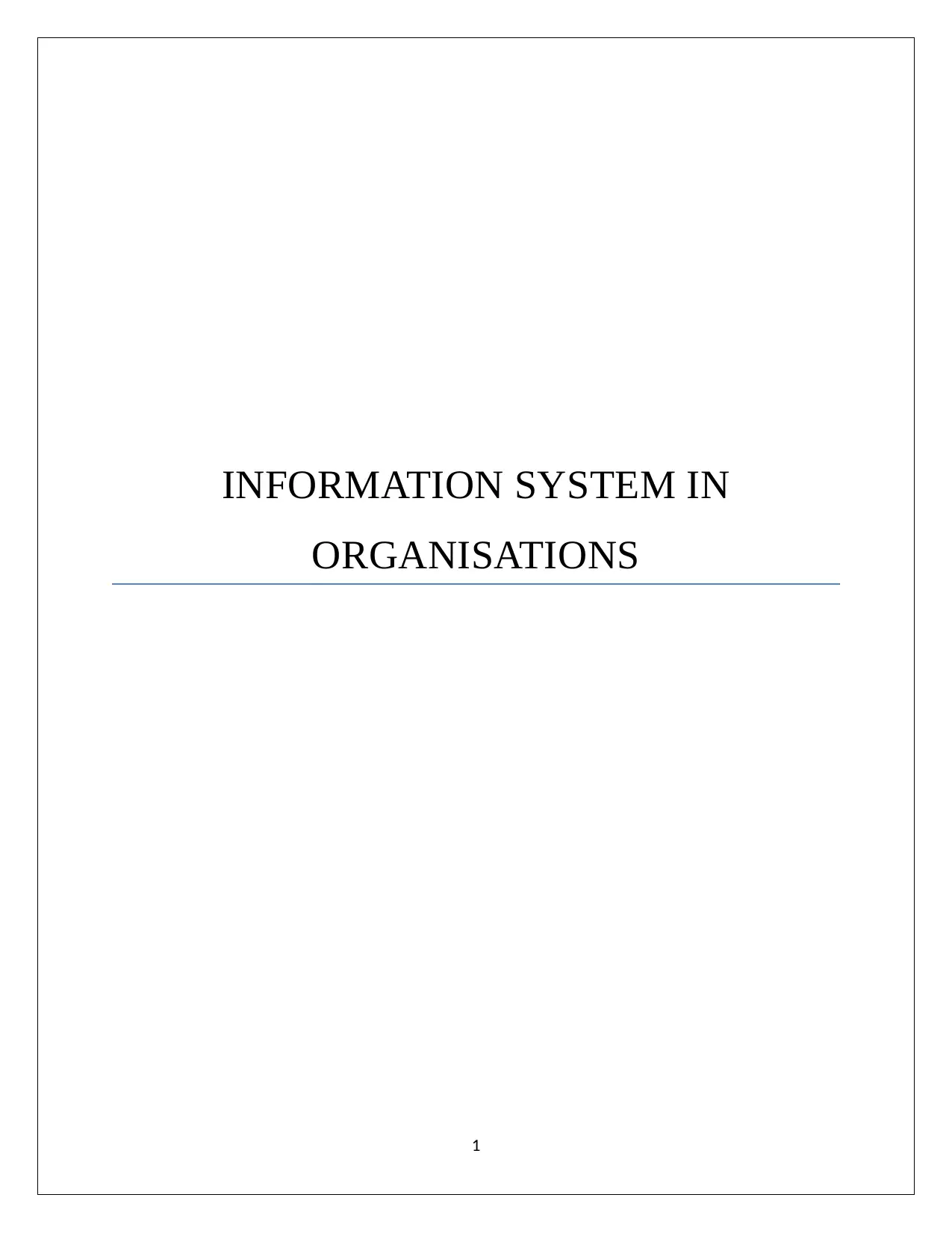
INFORMATION SYSTEM IN
ORGANISATIONS
1
ORGANISATIONS
1
Paraphrase This Document
Need a fresh take? Get an instant paraphrase of this document with our AI Paraphraser
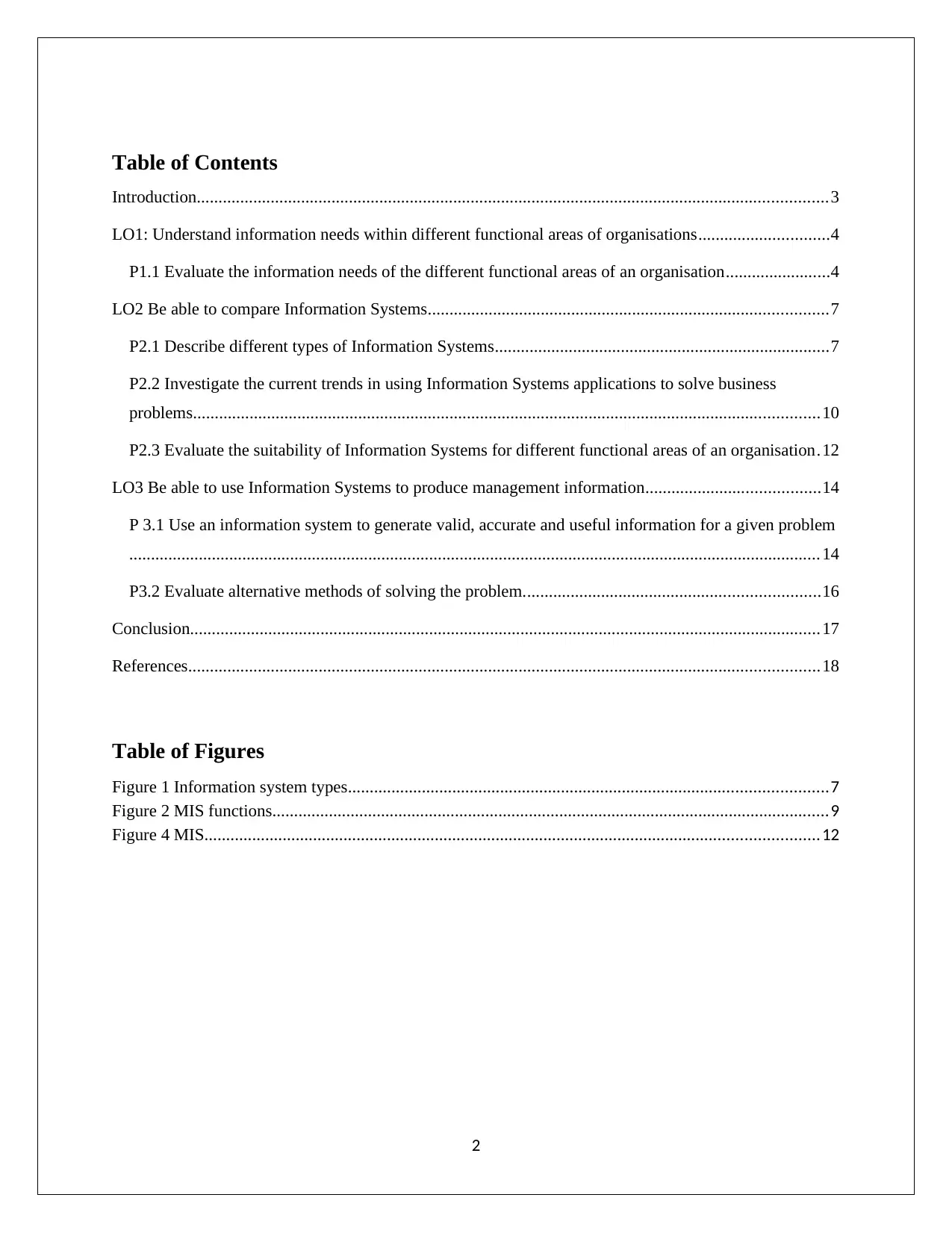
Table of Contents
Introduction.................................................................................................................................................3
LO1: Understand information needs within different functional areas of organisations..............................4
P1.1 Evaluate the information needs of the different functional areas of an organisation........................4
LO2 Be able to compare Information Systems............................................................................................7
P2.1 Describe different types of Information Systems.............................................................................7
P2.2 Investigate the current trends in using Information Systems applications to solve business
problems................................................................................................................................................10
P2.3 Evaluate the suitability of Information Systems for different functional areas of an organisation.12
LO3 Be able to use Information Systems to produce management information........................................14
P 3.1 Use an information system to generate valid, accurate and useful information for a given problem
...............................................................................................................................................................14
P3.2 Evaluate alternative methods of solving the problem....................................................................16
Conclusion.................................................................................................................................................17
References.................................................................................................................................................18
Table of Figures
Figure 1 Information system types..............................................................................................................7
Figure 2 MIS functions................................................................................................................................9
Figure 4 MIS.............................................................................................................................................12
2
Introduction.................................................................................................................................................3
LO1: Understand information needs within different functional areas of organisations..............................4
P1.1 Evaluate the information needs of the different functional areas of an organisation........................4
LO2 Be able to compare Information Systems............................................................................................7
P2.1 Describe different types of Information Systems.............................................................................7
P2.2 Investigate the current trends in using Information Systems applications to solve business
problems................................................................................................................................................10
P2.3 Evaluate the suitability of Information Systems for different functional areas of an organisation.12
LO3 Be able to use Information Systems to produce management information........................................14
P 3.1 Use an information system to generate valid, accurate and useful information for a given problem
...............................................................................................................................................................14
P3.2 Evaluate alternative methods of solving the problem....................................................................16
Conclusion.................................................................................................................................................17
References.................................................................................................................................................18
Table of Figures
Figure 1 Information system types..............................................................................................................7
Figure 2 MIS functions................................................................................................................................9
Figure 4 MIS.............................................................................................................................................12
2
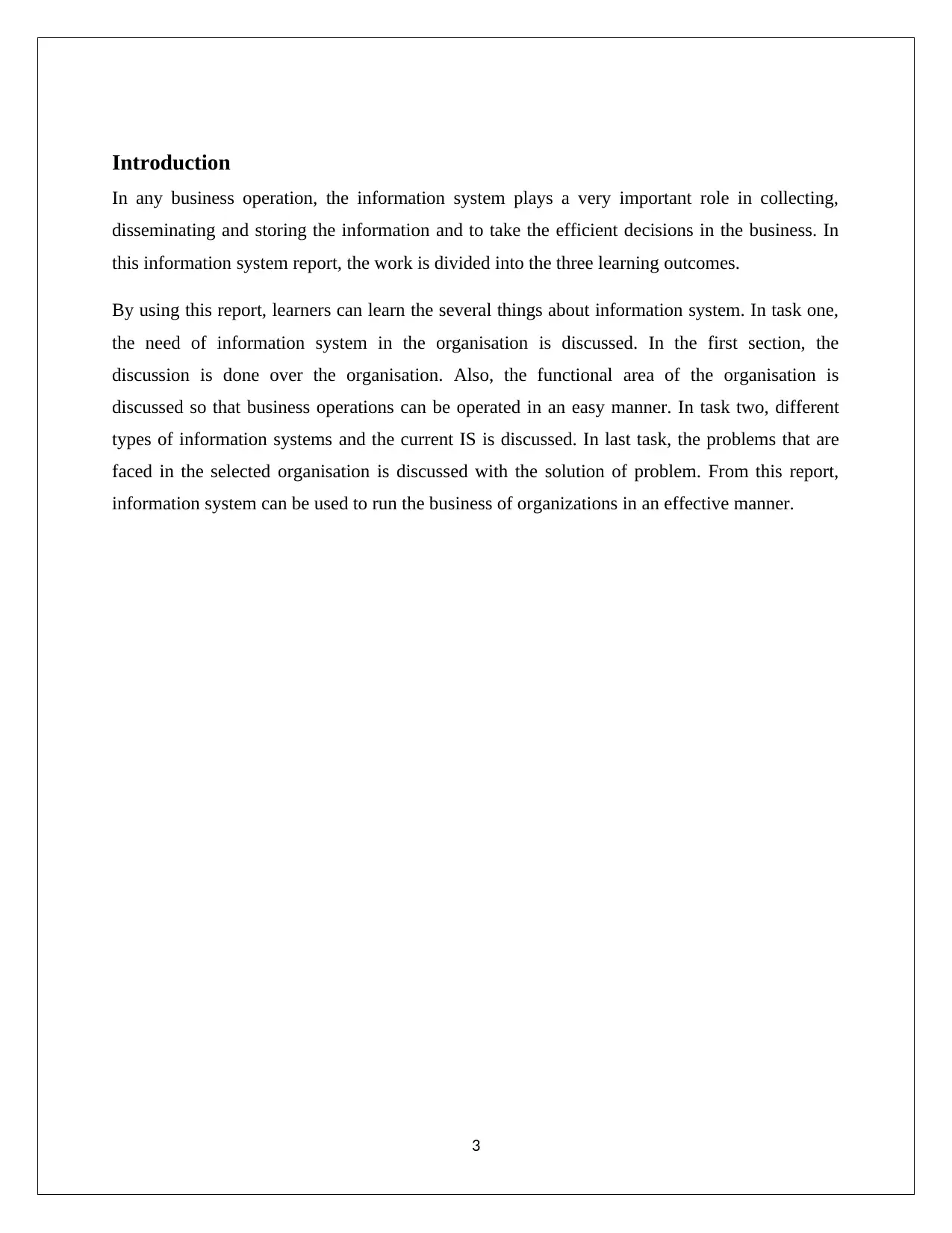
Introduction
In any business operation, the information system plays a very important role in collecting,
disseminating and storing the information and to take the efficient decisions in the business. In
this information system report, the work is divided into the three learning outcomes.
By using this report, learners can learn the several things about information system. In task one,
the need of information system in the organisation is discussed. In the first section, the
discussion is done over the organisation. Also, the functional area of the organisation is
discussed so that business operations can be operated in an easy manner. In task two, different
types of information systems and the current IS is discussed. In last task, the problems that are
faced in the selected organisation is discussed with the solution of problem. From this report,
information system can be used to run the business of organizations in an effective manner.
3
In any business operation, the information system plays a very important role in collecting,
disseminating and storing the information and to take the efficient decisions in the business. In
this information system report, the work is divided into the three learning outcomes.
By using this report, learners can learn the several things about information system. In task one,
the need of information system in the organisation is discussed. In the first section, the
discussion is done over the organisation. Also, the functional area of the organisation is
discussed so that business operations can be operated in an easy manner. In task two, different
types of information systems and the current IS is discussed. In last task, the problems that are
faced in the selected organisation is discussed with the solution of problem. From this report,
information system can be used to run the business of organizations in an effective manner.
3
⊘ This is a preview!⊘
Do you want full access?
Subscribe today to unlock all pages.

Trusted by 1+ million students worldwide
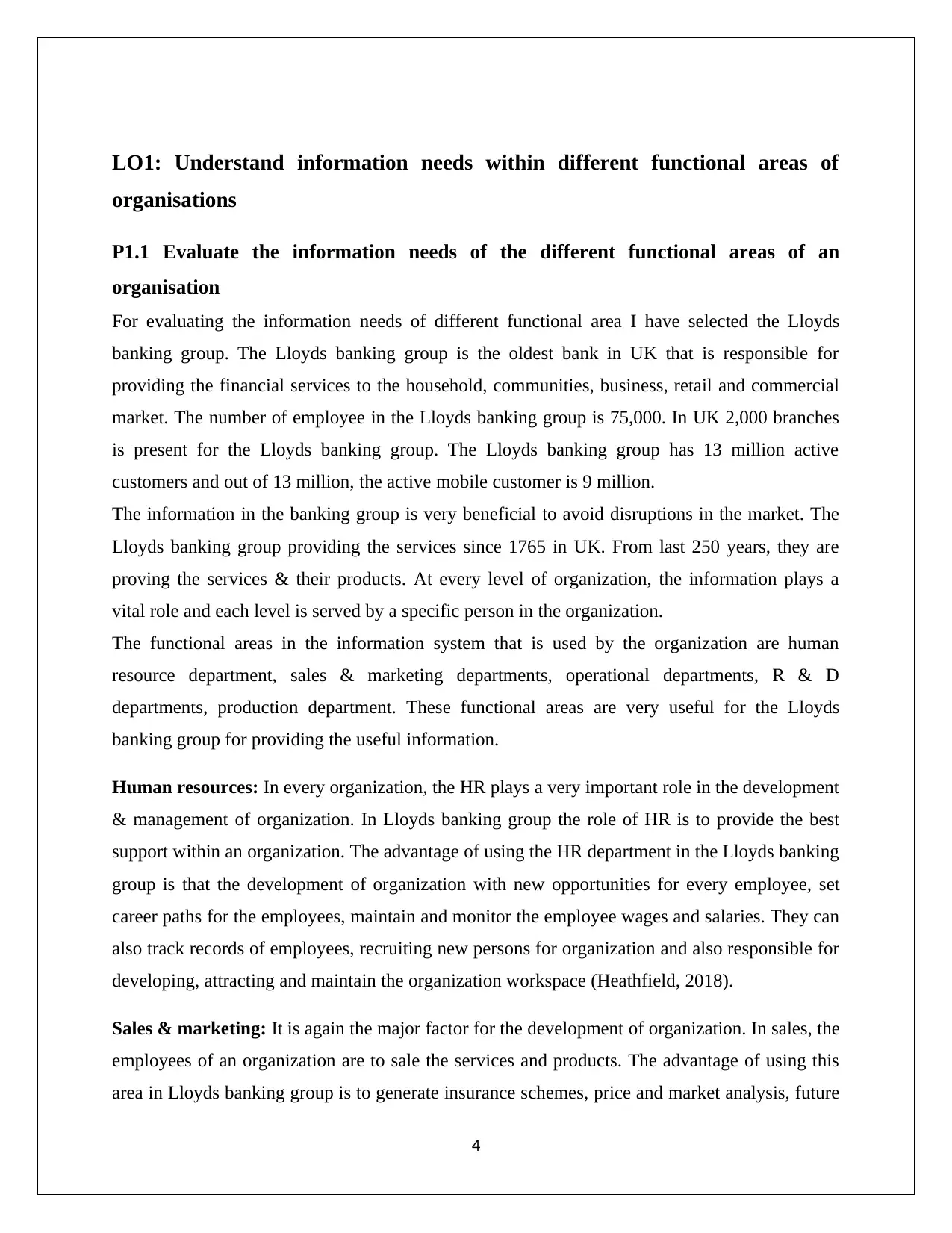
LO1: Understand information needs within different functional areas of
organisations
P1.1 Evaluate the information needs of the different functional areas of an
organisation
For evaluating the information needs of different functional area I have selected the Lloyds
banking group. The Lloyds banking group is the oldest bank in UK that is responsible for
providing the financial services to the household, communities, business, retail and commercial
market. The number of employee in the Lloyds banking group is 75,000. In UK 2,000 branches
is present for the Lloyds banking group. The Lloyds banking group has 13 million active
customers and out of 13 million, the active mobile customer is 9 million.
The information in the banking group is very beneficial to avoid disruptions in the market. The
Lloyds banking group providing the services since 1765 in UK. From last 250 years, they are
proving the services & their products. At every level of organization, the information plays a
vital role and each level is served by a specific person in the organization.
The functional areas in the information system that is used by the organization are human
resource department, sales & marketing departments, operational departments, R & D
departments, production department. These functional areas are very useful for the Lloyds
banking group for providing the useful information.
Human resources: In every organization, the HR plays a very important role in the development
& management of organization. In Lloyds banking group the role of HR is to provide the best
support within an organization. The advantage of using the HR department in the Lloyds banking
group is that the development of organization with new opportunities for every employee, set
career paths for the employees, maintain and monitor the employee wages and salaries. They can
also track records of employees, recruiting new persons for organization and also responsible for
developing, attracting and maintain the organization workspace (Heathfield, 2018).
Sales & marketing: It is again the major factor for the development of organization. In sales, the
employees of an organization are to sale the services and products. The advantage of using this
area in Lloyds banking group is to generate insurance schemes, price and market analysis, future
4
organisations
P1.1 Evaluate the information needs of the different functional areas of an
organisation
For evaluating the information needs of different functional area I have selected the Lloyds
banking group. The Lloyds banking group is the oldest bank in UK that is responsible for
providing the financial services to the household, communities, business, retail and commercial
market. The number of employee in the Lloyds banking group is 75,000. In UK 2,000 branches
is present for the Lloyds banking group. The Lloyds banking group has 13 million active
customers and out of 13 million, the active mobile customer is 9 million.
The information in the banking group is very beneficial to avoid disruptions in the market. The
Lloyds banking group providing the services since 1765 in UK. From last 250 years, they are
proving the services & their products. At every level of organization, the information plays a
vital role and each level is served by a specific person in the organization.
The functional areas in the information system that is used by the organization are human
resource department, sales & marketing departments, operational departments, R & D
departments, production department. These functional areas are very useful for the Lloyds
banking group for providing the useful information.
Human resources: In every organization, the HR plays a very important role in the development
& management of organization. In Lloyds banking group the role of HR is to provide the best
support within an organization. The advantage of using the HR department in the Lloyds banking
group is that the development of organization with new opportunities for every employee, set
career paths for the employees, maintain and monitor the employee wages and salaries. They can
also track records of employees, recruiting new persons for organization and also responsible for
developing, attracting and maintain the organization workspace (Heathfield, 2018).
Sales & marketing: It is again the major factor for the development of organization. In sales, the
employees of an organization are to sale the services and products. The advantage of using this
area in Lloyds banking group is to generate insurance schemes, price and market analysis, future
4
Paraphrase This Document
Need a fresh take? Get an instant paraphrase of this document with our AI Paraphraser
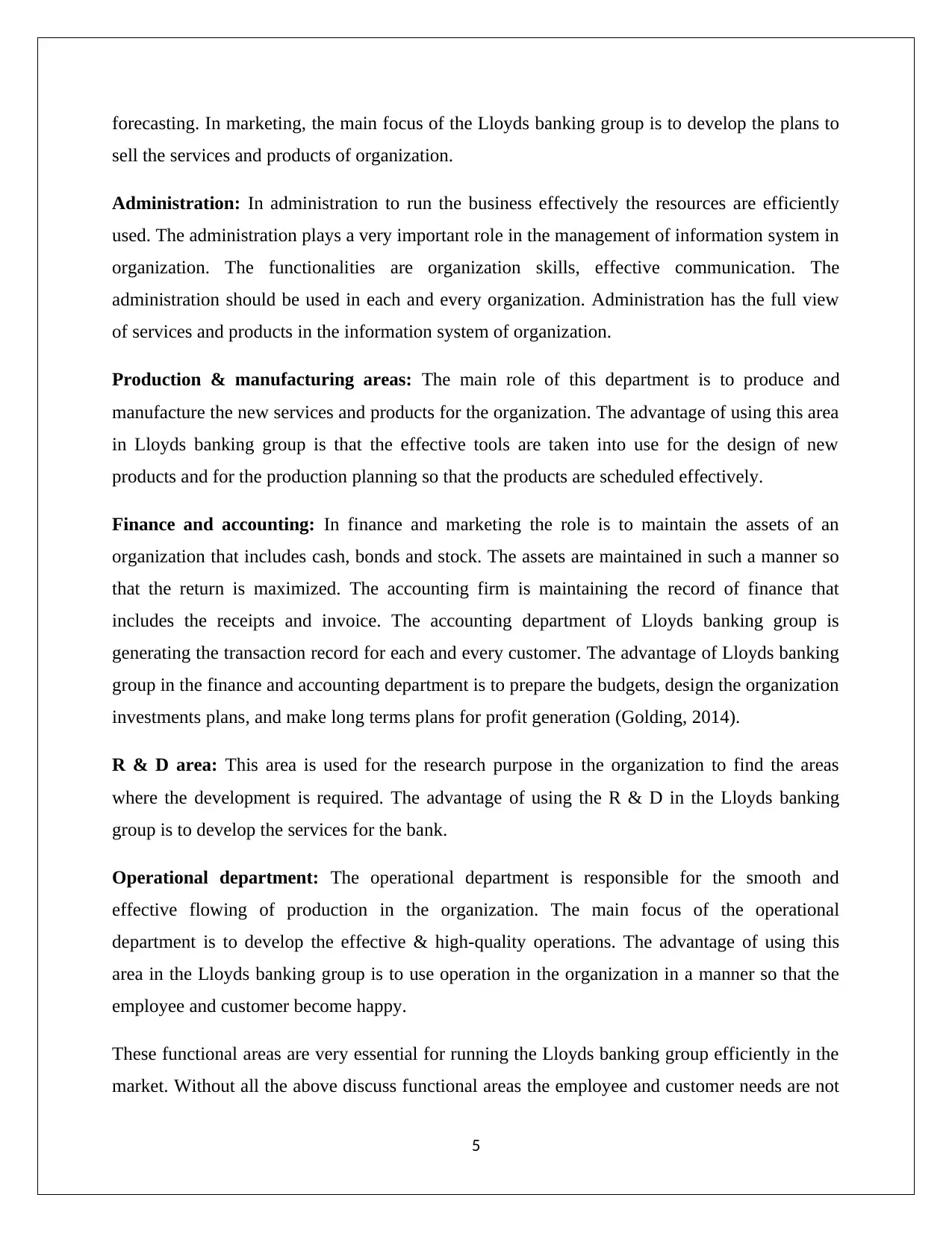
forecasting. In marketing, the main focus of the Lloyds banking group is to develop the plans to
sell the services and products of organization.
Administration: In administration to run the business effectively the resources are efficiently
used. The administration plays a very important role in the management of information system in
organization. The functionalities are organization skills, effective communication. The
administration should be used in each and every organization. Administration has the full view
of services and products in the information system of organization.
Production & manufacturing areas: The main role of this department is to produce and
manufacture the new services and products for the organization. The advantage of using this area
in Lloyds banking group is that the effective tools are taken into use for the design of new
products and for the production planning so that the products are scheduled effectively.
Finance and accounting: In finance and marketing the role is to maintain the assets of an
organization that includes cash, bonds and stock. The assets are maintained in such a manner so
that the return is maximized. The accounting firm is maintaining the record of finance that
includes the receipts and invoice. The accounting department of Lloyds banking group is
generating the transaction record for each and every customer. The advantage of Lloyds banking
group in the finance and accounting department is to prepare the budgets, design the organization
investments plans, and make long terms plans for profit generation (Golding, 2014).
R & D area: This area is used for the research purpose in the organization to find the areas
where the development is required. The advantage of using the R & D in the Lloyds banking
group is to develop the services for the bank.
Operational department: The operational department is responsible for the smooth and
effective flowing of production in the organization. The main focus of the operational
department is to develop the effective & high-quality operations. The advantage of using this
area in the Lloyds banking group is to use operation in the organization in a manner so that the
employee and customer become happy.
These functional areas are very essential for running the Lloyds banking group efficiently in the
market. Without all the above discuss functional areas the employee and customer needs are not
5
sell the services and products of organization.
Administration: In administration to run the business effectively the resources are efficiently
used. The administration plays a very important role in the management of information system in
organization. The functionalities are organization skills, effective communication. The
administration should be used in each and every organization. Administration has the full view
of services and products in the information system of organization.
Production & manufacturing areas: The main role of this department is to produce and
manufacture the new services and products for the organization. The advantage of using this area
in Lloyds banking group is that the effective tools are taken into use for the design of new
products and for the production planning so that the products are scheduled effectively.
Finance and accounting: In finance and marketing the role is to maintain the assets of an
organization that includes cash, bonds and stock. The assets are maintained in such a manner so
that the return is maximized. The accounting firm is maintaining the record of finance that
includes the receipts and invoice. The accounting department of Lloyds banking group is
generating the transaction record for each and every customer. The advantage of Lloyds banking
group in the finance and accounting department is to prepare the budgets, design the organization
investments plans, and make long terms plans for profit generation (Golding, 2014).
R & D area: This area is used for the research purpose in the organization to find the areas
where the development is required. The advantage of using the R & D in the Lloyds banking
group is to develop the services for the bank.
Operational department: The operational department is responsible for the smooth and
effective flowing of production in the organization. The main focus of the operational
department is to develop the effective & high-quality operations. The advantage of using this
area in the Lloyds banking group is to use operation in the organization in a manner so that the
employee and customer become happy.
These functional areas are very essential for running the Lloyds banking group efficiently in the
market. Without all the above discuss functional areas the employee and customer needs are not
5
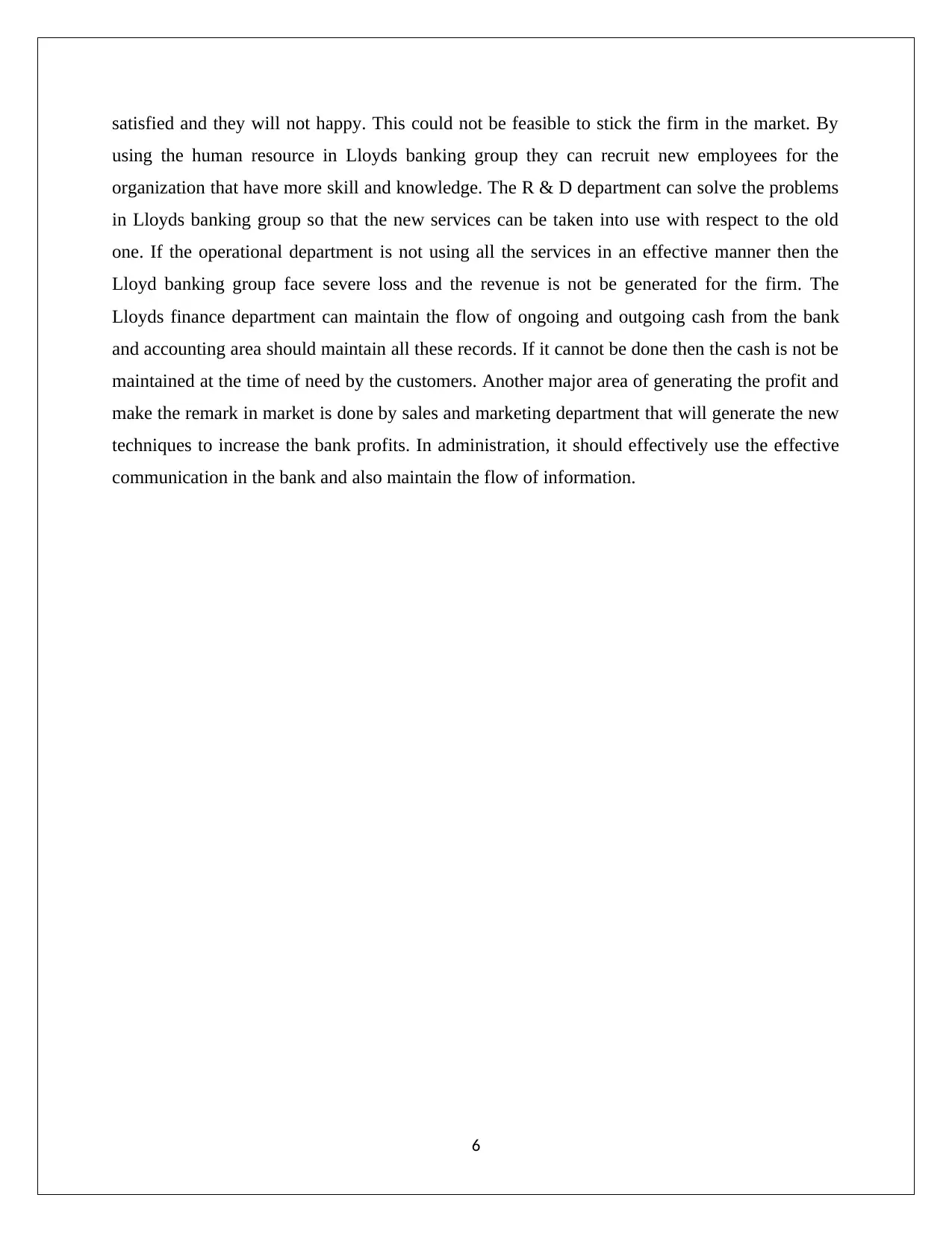
satisfied and they will not happy. This could not be feasible to stick the firm in the market. By
using the human resource in Lloyds banking group they can recruit new employees for the
organization that have more skill and knowledge. The R & D department can solve the problems
in Lloyds banking group so that the new services can be taken into use with respect to the old
one. If the operational department is not using all the services in an effective manner then the
Lloyd banking group face severe loss and the revenue is not be generated for the firm. The
Lloyds finance department can maintain the flow of ongoing and outgoing cash from the bank
and accounting area should maintain all these records. If it cannot be done then the cash is not be
maintained at the time of need by the customers. Another major area of generating the profit and
make the remark in market is done by sales and marketing department that will generate the new
techniques to increase the bank profits. In administration, it should effectively use the effective
communication in the bank and also maintain the flow of information.
6
using the human resource in Lloyds banking group they can recruit new employees for the
organization that have more skill and knowledge. The R & D department can solve the problems
in Lloyds banking group so that the new services can be taken into use with respect to the old
one. If the operational department is not using all the services in an effective manner then the
Lloyd banking group face severe loss and the revenue is not be generated for the firm. The
Lloyds finance department can maintain the flow of ongoing and outgoing cash from the bank
and accounting area should maintain all these records. If it cannot be done then the cash is not be
maintained at the time of need by the customers. Another major area of generating the profit and
make the remark in market is done by sales and marketing department that will generate the new
techniques to increase the bank profits. In administration, it should effectively use the effective
communication in the bank and also maintain the flow of information.
6
⊘ This is a preview!⊘
Do you want full access?
Subscribe today to unlock all pages.

Trusted by 1+ million students worldwide
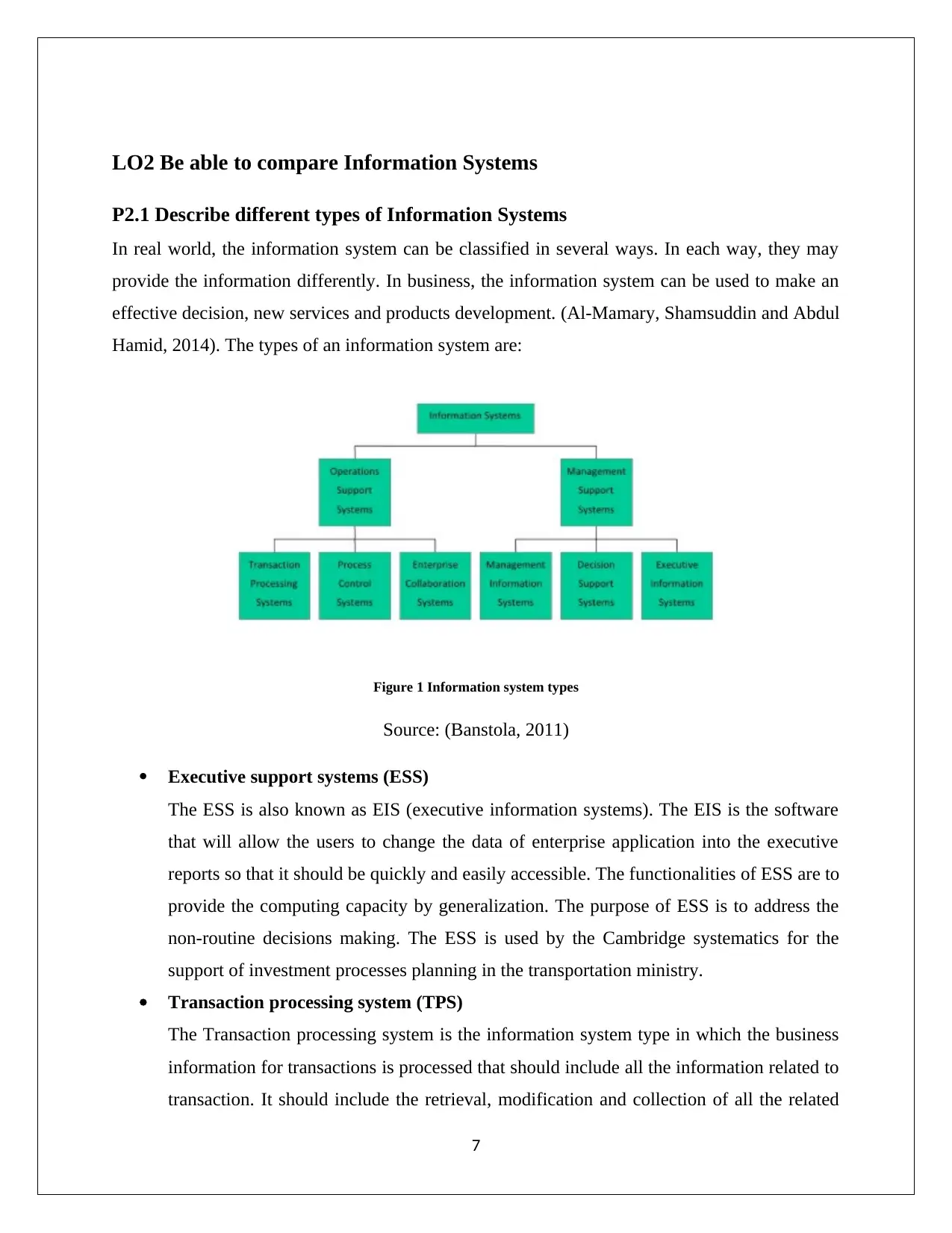
LO2 Be able to compare Information Systems
P2.1 Describe different types of Information Systems
In real world, the information system can be classified in several ways. In each way, they may
provide the information differently. In business, the information system can be used to make an
effective decision, new services and products development. (Al-Mamary, Shamsuddin and Abdul
Hamid, 2014). The types of an information system are:
Figure 1 Information system types
Source: (Banstola, 2011)
Executive support systems (ESS)
The ESS is also known as EIS (executive information systems). The EIS is the software
that will allow the users to change the data of enterprise application into the executive
reports so that it should be quickly and easily accessible. The functionalities of ESS are to
provide the computing capacity by generalization. The purpose of ESS is to address the
non-routine decisions making. The ESS is used by the Cambridge systematics for the
support of investment processes planning in the transportation ministry.
Transaction processing system (TPS)
The Transaction processing system is the information system type in which the business
information for transactions is processed that should include all the information related to
transaction. It should include the retrieval, modification and collection of all the related
7
P2.1 Describe different types of Information Systems
In real world, the information system can be classified in several ways. In each way, they may
provide the information differently. In business, the information system can be used to make an
effective decision, new services and products development. (Al-Mamary, Shamsuddin and Abdul
Hamid, 2014). The types of an information system are:
Figure 1 Information system types
Source: (Banstola, 2011)
Executive support systems (ESS)
The ESS is also known as EIS (executive information systems). The EIS is the software
that will allow the users to change the data of enterprise application into the executive
reports so that it should be quickly and easily accessible. The functionalities of ESS are to
provide the computing capacity by generalization. The purpose of ESS is to address the
non-routine decisions making. The ESS is used by the Cambridge systematics for the
support of investment processes planning in the transportation ministry.
Transaction processing system (TPS)
The Transaction processing system is the information system type in which the business
information for transactions is processed that should include all the information related to
transaction. It should include the retrieval, modification and collection of all the related
7
Paraphrase This Document
Need a fresh take? Get an instant paraphrase of this document with our AI Paraphraser
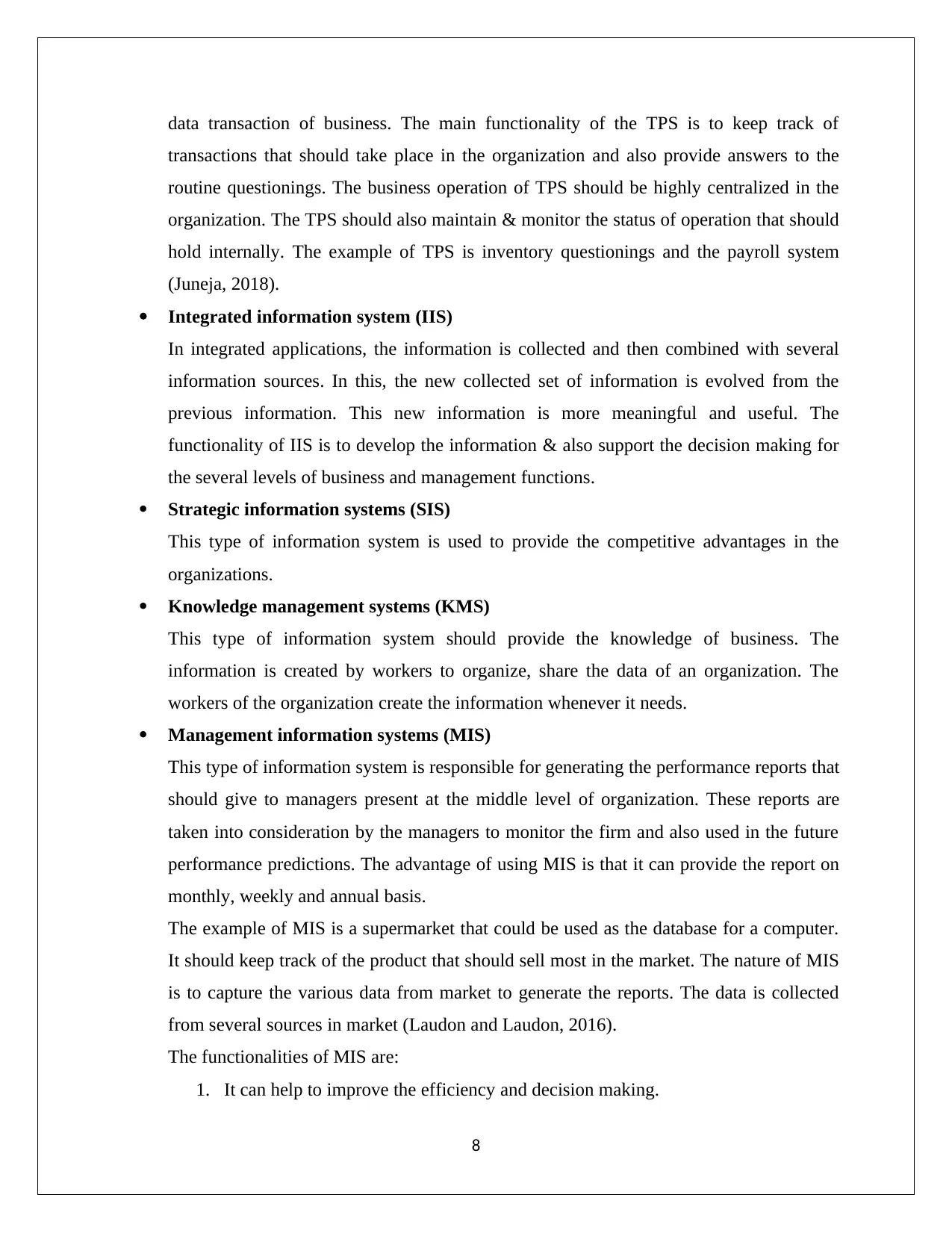
data transaction of business. The main functionality of the TPS is to keep track of
transactions that should take place in the organization and also provide answers to the
routine questionings. The business operation of TPS should be highly centralized in the
organization. The TPS should also maintain & monitor the status of operation that should
hold internally. The example of TPS is inventory questionings and the payroll system
(Juneja, 2018).
Integrated information system (IIS)
In integrated applications, the information is collected and then combined with several
information sources. In this, the new collected set of information is evolved from the
previous information. This new information is more meaningful and useful. The
functionality of IIS is to develop the information & also support the decision making for
the several levels of business and management functions.
Strategic information systems (SIS)
This type of information system is used to provide the competitive advantages in the
organizations.
Knowledge management systems (KMS)
This type of information system should provide the knowledge of business. The
information is created by workers to organize, share the data of an organization. The
workers of the organization create the information whenever it needs.
Management information systems (MIS)
This type of information system is responsible for generating the performance reports that
should give to managers present at the middle level of organization. These reports are
taken into consideration by the managers to monitor the firm and also used in the future
performance predictions. The advantage of using MIS is that it can provide the report on
monthly, weekly and annual basis.
The example of MIS is a supermarket that could be used as the database for a computer.
It should keep track of the product that should sell most in the market. The nature of MIS
is to capture the various data from market to generate the reports. The data is collected
from several sources in market (Laudon and Laudon, 2016).
The functionalities of MIS are:
1. It can help to improve the efficiency and decision making.
8
transactions that should take place in the organization and also provide answers to the
routine questionings. The business operation of TPS should be highly centralized in the
organization. The TPS should also maintain & monitor the status of operation that should
hold internally. The example of TPS is inventory questionings and the payroll system
(Juneja, 2018).
Integrated information system (IIS)
In integrated applications, the information is collected and then combined with several
information sources. In this, the new collected set of information is evolved from the
previous information. This new information is more meaningful and useful. The
functionality of IIS is to develop the information & also support the decision making for
the several levels of business and management functions.
Strategic information systems (SIS)
This type of information system is used to provide the competitive advantages in the
organizations.
Knowledge management systems (KMS)
This type of information system should provide the knowledge of business. The
information is created by workers to organize, share the data of an organization. The
workers of the organization create the information whenever it needs.
Management information systems (MIS)
This type of information system is responsible for generating the performance reports that
should give to managers present at the middle level of organization. These reports are
taken into consideration by the managers to monitor the firm and also used in the future
performance predictions. The advantage of using MIS is that it can provide the report on
monthly, weekly and annual basis.
The example of MIS is a supermarket that could be used as the database for a computer.
It should keep track of the product that should sell most in the market. The nature of MIS
is to capture the various data from market to generate the reports. The data is collected
from several sources in market (Laudon and Laudon, 2016).
The functionalities of MIS are:
1. It can help to improve the efficiency and decision making.
8
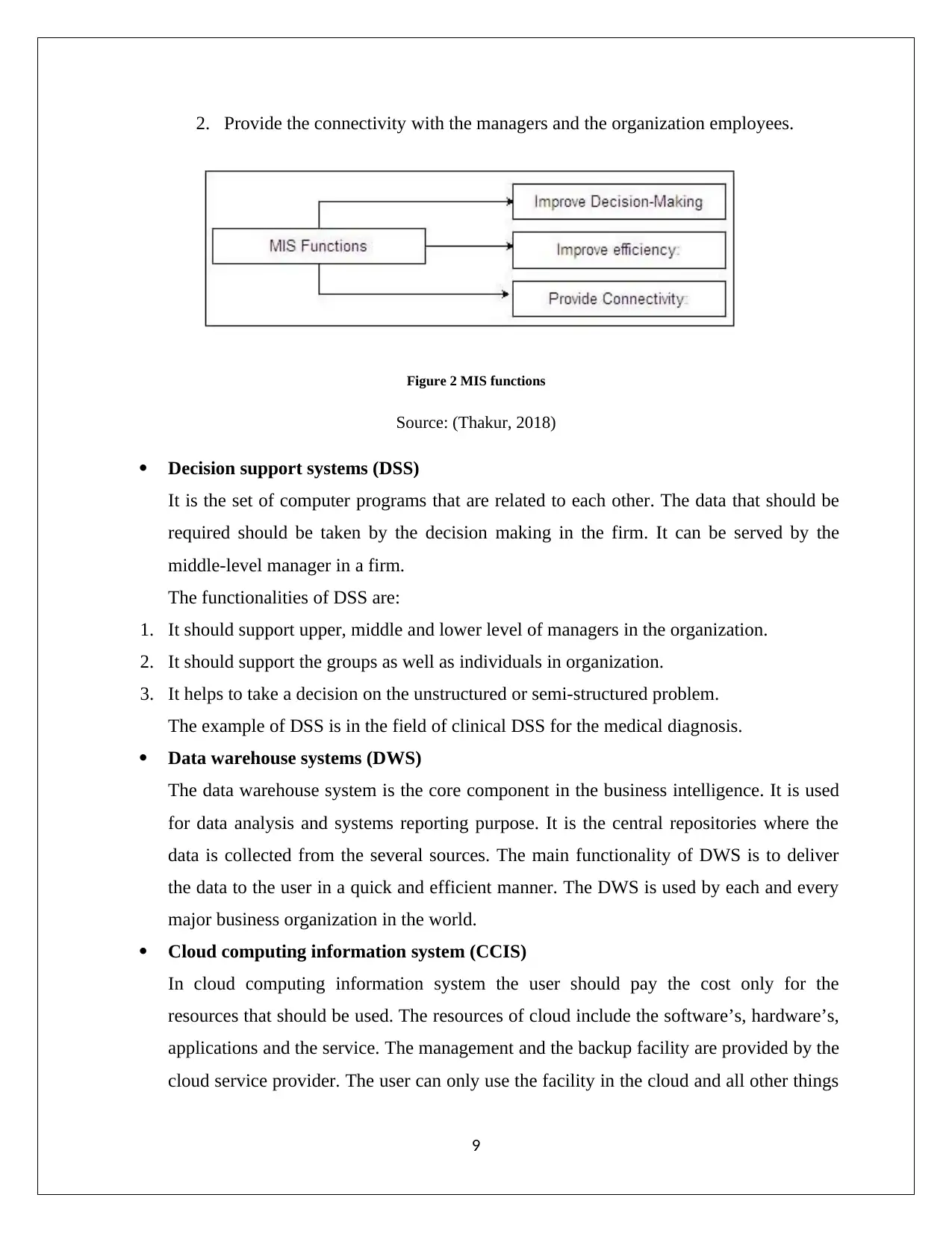
2. Provide the connectivity with the managers and the organization employees.
Figure 2 MIS functions
Source: (Thakur, 2018)
Decision support systems (DSS)
It is the set of computer programs that are related to each other. The data that should be
required should be taken by the decision making in the firm. It can be served by the
middle-level manager in a firm.
The functionalities of DSS are:
1. It should support upper, middle and lower level of managers in the organization.
2. It should support the groups as well as individuals in organization.
3. It helps to take a decision on the unstructured or semi-structured problem.
The example of DSS is in the field of clinical DSS for the medical diagnosis.
Data warehouse systems (DWS)
The data warehouse system is the core component in the business intelligence. It is used
for data analysis and systems reporting purpose. It is the central repositories where the
data is collected from the several sources. The main functionality of DWS is to deliver
the data to the user in a quick and efficient manner. The DWS is used by each and every
major business organization in the world.
Cloud computing information system (CCIS)
In cloud computing information system the user should pay the cost only for the
resources that should be used. The resources of cloud include the software’s, hardware’s,
applications and the service. The management and the backup facility are provided by the
cloud service provider. The user can only use the facility in the cloud and all other things
9
Figure 2 MIS functions
Source: (Thakur, 2018)
Decision support systems (DSS)
It is the set of computer programs that are related to each other. The data that should be
required should be taken by the decision making in the firm. It can be served by the
middle-level manager in a firm.
The functionalities of DSS are:
1. It should support upper, middle and lower level of managers in the organization.
2. It should support the groups as well as individuals in organization.
3. It helps to take a decision on the unstructured or semi-structured problem.
The example of DSS is in the field of clinical DSS for the medical diagnosis.
Data warehouse systems (DWS)
The data warehouse system is the core component in the business intelligence. It is used
for data analysis and systems reporting purpose. It is the central repositories where the
data is collected from the several sources. The main functionality of DWS is to deliver
the data to the user in a quick and efficient manner. The DWS is used by each and every
major business organization in the world.
Cloud computing information system (CCIS)
In cloud computing information system the user should pay the cost only for the
resources that should be used. The resources of cloud include the software’s, hardware’s,
applications and the service. The management and the backup facility are provided by the
cloud service provider. The user can only use the facility in the cloud and all other things
9
⊘ This is a preview!⊘
Do you want full access?
Subscribe today to unlock all pages.

Trusted by 1+ million students worldwide
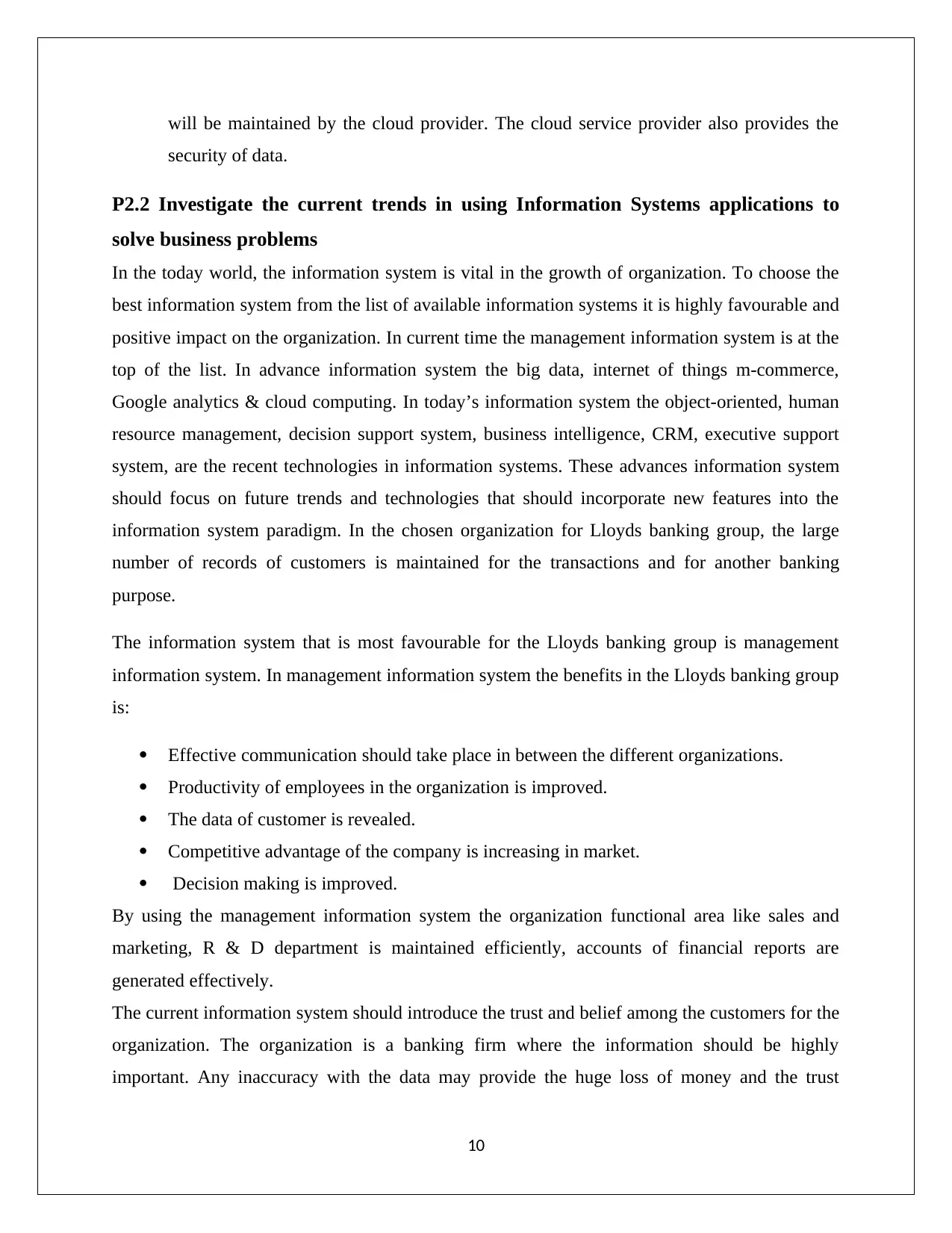
will be maintained by the cloud provider. The cloud service provider also provides the
security of data.
P2.2 Investigate the current trends in using Information Systems applications to
solve business problems
In the today world, the information system is vital in the growth of organization. To choose the
best information system from the list of available information systems it is highly favourable and
positive impact on the organization. In current time the management information system is at the
top of the list. In advance information system the big data, internet of things m-commerce,
Google analytics & cloud computing. In today’s information system the object-oriented, human
resource management, decision support system, business intelligence, CRM, executive support
system, are the recent technologies in information systems. These advances information system
should focus on future trends and technologies that should incorporate new features into the
information system paradigm. In the chosen organization for Lloyds banking group, the large
number of records of customers is maintained for the transactions and for another banking
purpose.
The information system that is most favourable for the Lloyds banking group is management
information system. In management information system the benefits in the Lloyds banking group
is:
Effective communication should take place in between the different organizations.
Productivity of employees in the organization is improved.
The data of customer is revealed.
Competitive advantage of the company is increasing in market.
Decision making is improved.
By using the management information system the organization functional area like sales and
marketing, R & D department is maintained efficiently, accounts of financial reports are
generated effectively.
The current information system should introduce the trust and belief among the customers for the
organization. The organization is a banking firm where the information should be highly
important. Any inaccuracy with the data may provide the huge loss of money and the trust
10
security of data.
P2.2 Investigate the current trends in using Information Systems applications to
solve business problems
In the today world, the information system is vital in the growth of organization. To choose the
best information system from the list of available information systems it is highly favourable and
positive impact on the organization. In current time the management information system is at the
top of the list. In advance information system the big data, internet of things m-commerce,
Google analytics & cloud computing. In today’s information system the object-oriented, human
resource management, decision support system, business intelligence, CRM, executive support
system, are the recent technologies in information systems. These advances information system
should focus on future trends and technologies that should incorporate new features into the
information system paradigm. In the chosen organization for Lloyds banking group, the large
number of records of customers is maintained for the transactions and for another banking
purpose.
The information system that is most favourable for the Lloyds banking group is management
information system. In management information system the benefits in the Lloyds banking group
is:
Effective communication should take place in between the different organizations.
Productivity of employees in the organization is improved.
The data of customer is revealed.
Competitive advantage of the company is increasing in market.
Decision making is improved.
By using the management information system the organization functional area like sales and
marketing, R & D department is maintained efficiently, accounts of financial reports are
generated effectively.
The current information system should introduce the trust and belief among the customers for the
organization. The organization is a banking firm where the information should be highly
important. Any inaccuracy with the data may provide the huge loss of money and the trust
10
Paraphrase This Document
Need a fresh take? Get an instant paraphrase of this document with our AI Paraphraser
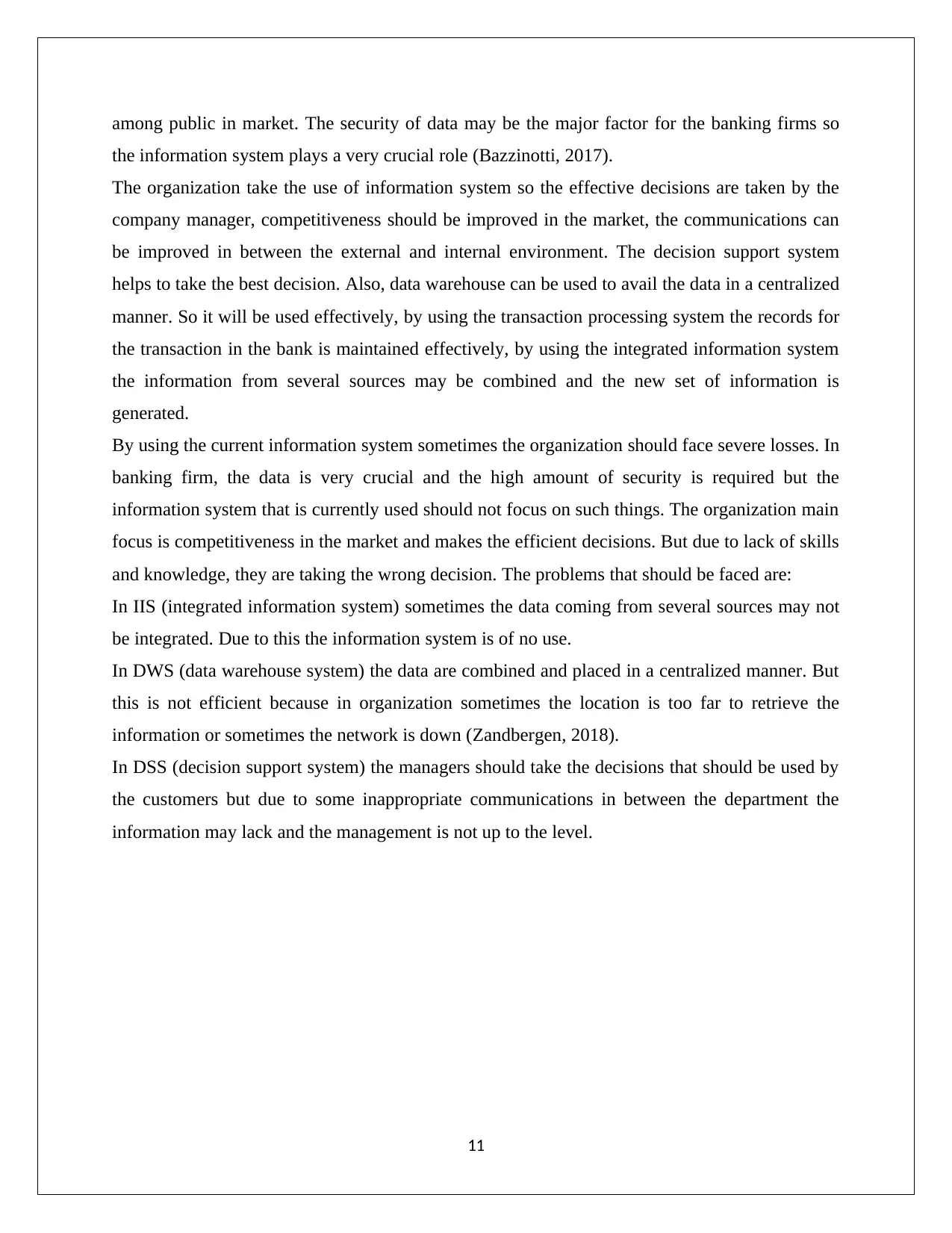
among public in market. The security of data may be the major factor for the banking firms so
the information system plays a very crucial role (Bazzinotti, 2017).
The organization take the use of information system so the effective decisions are taken by the
company manager, competitiveness should be improved in the market, the communications can
be improved in between the external and internal environment. The decision support system
helps to take the best decision. Also, data warehouse can be used to avail the data in a centralized
manner. So it will be used effectively, by using the transaction processing system the records for
the transaction in the bank is maintained effectively, by using the integrated information system
the information from several sources may be combined and the new set of information is
generated.
By using the current information system sometimes the organization should face severe losses. In
banking firm, the data is very crucial and the high amount of security is required but the
information system that is currently used should not focus on such things. The organization main
focus is competitiveness in the market and makes the efficient decisions. But due to lack of skills
and knowledge, they are taking the wrong decision. The problems that should be faced are:
In IIS (integrated information system) sometimes the data coming from several sources may not
be integrated. Due to this the information system is of no use.
In DWS (data warehouse system) the data are combined and placed in a centralized manner. But
this is not efficient because in organization sometimes the location is too far to retrieve the
information or sometimes the network is down (Zandbergen, 2018).
In DSS (decision support system) the managers should take the decisions that should be used by
the customers but due to some inappropriate communications in between the department the
information may lack and the management is not up to the level.
11
the information system plays a very crucial role (Bazzinotti, 2017).
The organization take the use of information system so the effective decisions are taken by the
company manager, competitiveness should be improved in the market, the communications can
be improved in between the external and internal environment. The decision support system
helps to take the best decision. Also, data warehouse can be used to avail the data in a centralized
manner. So it will be used effectively, by using the transaction processing system the records for
the transaction in the bank is maintained effectively, by using the integrated information system
the information from several sources may be combined and the new set of information is
generated.
By using the current information system sometimes the organization should face severe losses. In
banking firm, the data is very crucial and the high amount of security is required but the
information system that is currently used should not focus on such things. The organization main
focus is competitiveness in the market and makes the efficient decisions. But due to lack of skills
and knowledge, they are taking the wrong decision. The problems that should be faced are:
In IIS (integrated information system) sometimes the data coming from several sources may not
be integrated. Due to this the information system is of no use.
In DWS (data warehouse system) the data are combined and placed in a centralized manner. But
this is not efficient because in organization sometimes the location is too far to retrieve the
information or sometimes the network is down (Zandbergen, 2018).
In DSS (decision support system) the managers should take the decisions that should be used by
the customers but due to some inappropriate communications in between the department the
information may lack and the management is not up to the level.
11
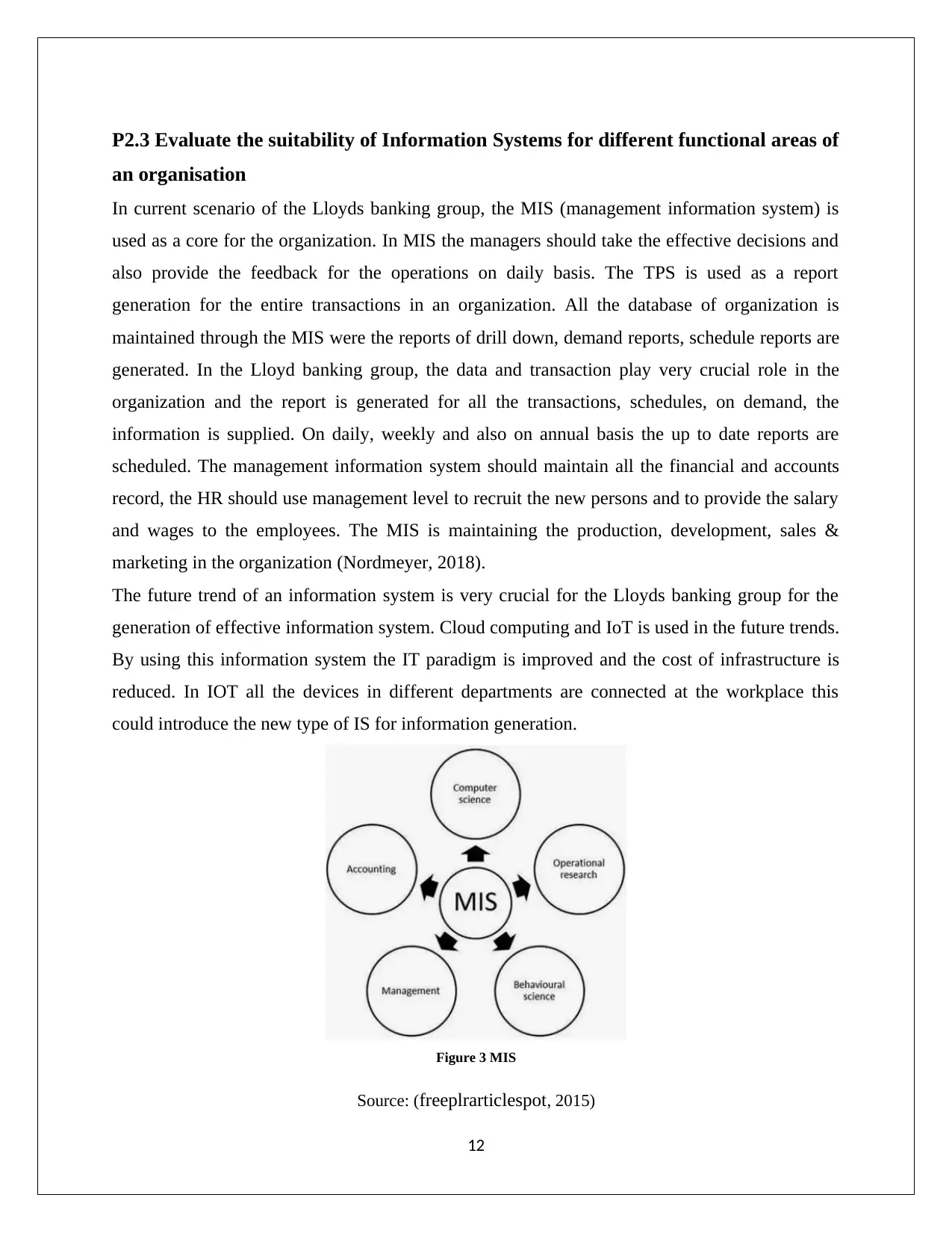
P2.3 Evaluate the suitability of Information Systems for different functional areas of
an organisation
In current scenario of the Lloyds banking group, the MIS (management information system) is
used as a core for the organization. In MIS the managers should take the effective decisions and
also provide the feedback for the operations on daily basis. The TPS is used as a report
generation for the entire transactions in an organization. All the database of organization is
maintained through the MIS were the reports of drill down, demand reports, schedule reports are
generated. In the Lloyd banking group, the data and transaction play very crucial role in the
organization and the report is generated for all the transactions, schedules, on demand, the
information is supplied. On daily, weekly and also on annual basis the up to date reports are
scheduled. The management information system should maintain all the financial and accounts
record, the HR should use management level to recruit the new persons and to provide the salary
and wages to the employees. The MIS is maintaining the production, development, sales &
marketing in the organization (Nordmeyer, 2018).
The future trend of an information system is very crucial for the Lloyds banking group for the
generation of effective information system. Cloud computing and IoT is used in the future trends.
By using this information system the IT paradigm is improved and the cost of infrastructure is
reduced. In IOT all the devices in different departments are connected at the workplace this
could introduce the new type of IS for information generation.
Figure 3 MIS
Source: (freeplrarticlespot, 2015)
12
an organisation
In current scenario of the Lloyds banking group, the MIS (management information system) is
used as a core for the organization. In MIS the managers should take the effective decisions and
also provide the feedback for the operations on daily basis. The TPS is used as a report
generation for the entire transactions in an organization. All the database of organization is
maintained through the MIS were the reports of drill down, demand reports, schedule reports are
generated. In the Lloyd banking group, the data and transaction play very crucial role in the
organization and the report is generated for all the transactions, schedules, on demand, the
information is supplied. On daily, weekly and also on annual basis the up to date reports are
scheduled. The management information system should maintain all the financial and accounts
record, the HR should use management level to recruit the new persons and to provide the salary
and wages to the employees. The MIS is maintaining the production, development, sales &
marketing in the organization (Nordmeyer, 2018).
The future trend of an information system is very crucial for the Lloyds banking group for the
generation of effective information system. Cloud computing and IoT is used in the future trends.
By using this information system the IT paradigm is improved and the cost of infrastructure is
reduced. In IOT all the devices in different departments are connected at the workplace this
could introduce the new type of IS for information generation.
Figure 3 MIS
Source: (freeplrarticlespot, 2015)
12
⊘ This is a preview!⊘
Do you want full access?
Subscribe today to unlock all pages.

Trusted by 1+ million students worldwide
1 out of 19
Related Documents
Your All-in-One AI-Powered Toolkit for Academic Success.
+13062052269
info@desklib.com
Available 24*7 on WhatsApp / Email
![[object Object]](/_next/static/media/star-bottom.7253800d.svg)
Unlock your academic potential
Copyright © 2020–2025 A2Z Services. All Rights Reserved. Developed and managed by ZUCOL.




